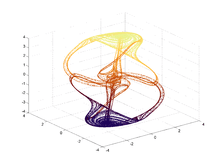Thomas' cyclically symmetric attractor

In the dynamical systems theory, Thomas' cyclically symmetric attractor is a 3D strange attractor originally proposed by René Thomas.[1] It has a simple form which is cyclically symmetric in the x,y, and z variables and can be viewed as the trajectory of a frictionally dampened particle moving in a 3D lattice of forces.[2] The simple form has made it a popular example.
It is described by the differential equations
where is a constant.
corresponds to how dissipative the system is, and acts as a bifurcation parameter. For the origin is the single stable equilibrium. At it undergoes a pitchfork bifurcation, splitting into two attractive fixed points. As the parameter is decreased further they undergo a Hopf bifurcation at , creating a stable limit cycle. The limit cycle the undergoes a period doubling cascade and becomes chaotic at . Beyond this the attractor expands, undergoing a series of crises (up to six separate attractors can coexist for certain values). The fractal dimension of the attractor increases towards 3.[2]
In the limit the system lacks dissipation and the trajectory ergodically wanders the entire space (with an exception for 1.67%, where it drifts parallel to one of the coordinate axes: this corresponds to quasiperiodic torii). The dynamics has been described as deterministic fractional Brownian motion, and exhibits anomalous diffusion.[2][3]
References
- ↑ Thomas, René (1999). "Deterministic chaos seen in terms of feedback circuits: Analysis, synthesis, 'labyrinth chaos'". Int. J. Bifurcation and Chaos. 9 (10): 1889–1905. doi:10.1142/S0218127499001383.
- 1 2 3 Sprott, J. C.; Chlouverakis, Konstantinos E. (2007). "Labyrinth Chaos". Int. J. Bifurcation Chaos. 17 (6): 2097. doi:10.1142/S0218127407018245.
- ↑ Rowlands, G.; Sprott, J. C. (2008). "A simple diffusion model showing anomalous scaling". Physics of Plasmas. 15: 082308. doi:10.1063/1.2969429.